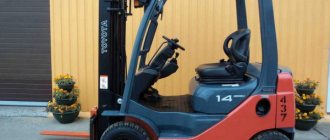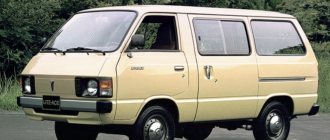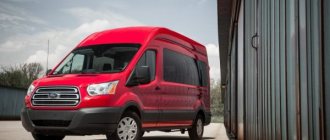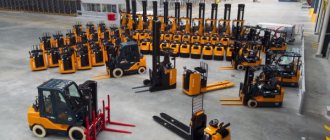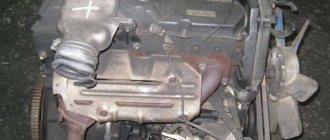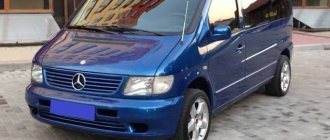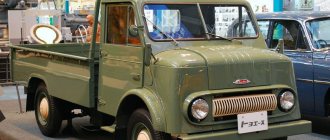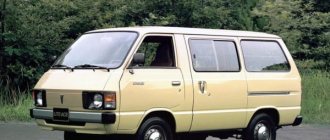This truck was designed by Toyota in collaboration with Daihatsu, and is developed and manufactured exclusively by Daihatsu. The 1.5-liter engine is located under the seats, and the wheels spaced at the corners and the short front overhang create a “box-shaped” silhouette. The windshield pillars have a fairly slight slope, which ensures comfortable entry and exit, as well as good visibility.
The cargo area has the highest floor level in the class and is equipped with three tailgates. There are hooks for attaching the cable. A pleasant impression is made by the rational height of the seats and thresholds, as well as the simple layout of the instrument panel and various switches. The top-end “X Edition” package includes a painted bumper, combined seat and door upholstery (with fabric inserts), electric door locks and electric windows. (January 2008)
The DX X Edition adds a feature that automatically raises the driver's window at the touch of a button. (December 2009)
All modifications are now available in all-wheel drive with a locking center differential. All-wheel drive models are also equipped with equipment for regions with cold climates. Based on the “DX” modification, a truck was created with a special “Power Lift” device, which ensures easier loading and unloading. (July 2010)
The Toyota Lit Ice minivan is an analogue of a truck called Town Ice. These vehicles are predominantly found in countries where cars drive on the left. Also, quite often such cars can be seen on the roads of the Russian Federation.
History and modifications of the vehicle
Toyota Light Ace began production back in 1970. Until 1986, it was distinguished exclusively by its rear-wheel drive version. After this year, the company switched to all-wheel drive with the function of forced connection of the front axle.
Until 1996, the Toyota Lite Ace was produced in the form of a frame minivan, which could be made in two types. The passenger form of the car meant from 7 to 9 seats, and the cargo form meant only 5 seats. There were the following modifications of the vehicle:
- DX. This type of Toyota was a Lite Ace cargo truck with an air conditioning system.
- AXL. This Toyota model was characterized as an improved Lite Ace cargo type. As additions, electric window drives were installed on it. In addition, the optical instruments on this machine have significantly improved.
- GXL. The manufacturer positioned this modification of the Toyota Light Ace car as a passenger car. It also differed from the improved cargo version in that it was equipped with a radio that played CDs, an additional air conditioner or a heater for the interior, as well as electric drives for windows and hatches.
- FXV. This Toyota Lit Ice truck was considered an improved passenger version. As additional elements, it contained such things as: a refrigerator, curtains operating by electric drive, as well as electrically heated rear-view mirrors.
The Toyota Lit Ice truck and passenger car were significantly updated after 1996, after which they were produced in this way until 2001. After this, these vehicles were replaced by a new company car called Noah.
Modifications
Until 1996, the car was based on a frame chassis and was offered to consumers in two main versions, namely passenger and cargo. The passenger version has 7 or 9 seats, while the cargo version has only 5.
Among the main modifications of the Toyota Lite Ace model, the following versions should be highlighted:
- Modification DX. A vehicle with this index is a cargo vehicle. There is an air conditioning system;
- Modification AXL. It is an improved version of the previous modification. It's also a truck, but has power windows and updated lighting equipment;
- Modification GXL. It is a passenger version. The modification is equipped with electric windows, a radio with support for CDs, an additional air conditioner or heater, and an electric sunroof;
- Modification FXV. It is a cargo variation of the Toyota Lite Ace. This version was equipped with a refrigerator, electrically operated curtains, and electrically heated side mirrors. In addition, there are also electric windows with air conditioning.
- In the period from 1996 to 2001, the manufacturer also produced such a modification as the Toyota Lite Ace Noah. This model was in many ways similar to the standard car, but had a slightly modified appearance. The base power unit was a 3S-FE gasoline engine, developing a maximum output power of 130 horsepower with a displacement of 2.0 liters. In 1998, this modification was restyled, but the changes were minor.
- In 2008, the model range was supplemented by the Toyota Lite Ace Truck modification, which is a modern flatbed truck. Only one power unit of the 3SZ-VE brand was offered for it. Its working volume is 1.5 liters, and the maximum output power reaches 97 horsepower.
Dimensions of various minivan models
When choosing a car, many motorists pay attention not only to its technical characteristics and description, but also to parameters such as body dimensions. It is believed that the larger the vehicle, the harder it is to drive, which significantly affects such factors as safety.
Depending on the modification of the Toyota Light Ace car, its dimensions may vary slightly. First of all, this concerns the overall dimensions, which are the length, width and height of the body. All these dimensions are usually given in millimeters to allow clear comparison of different types of machines.
Owner reviews
Vladimir, Kurgan. Toyota Light Ace 1998, body KR42
I was looking for a roomy, spacious and high-torque car, definitely 4 WD. Before this, there were several cars, including Mazda, VAZ 2106 and Opel - all in average condition. I decided to spend money on something worthwhile, and therefore turned my attention to the Japanese - Toyota Lite Ace Truck. Unfortunately, there was not enough finances for a new Noah. I've been looking at this one for a long time, because they sell a lot of "killed" things - I had to travel, even to the nearest cities. In the end, I bought a five-door with the Super package for 190 thousand rubles, on gasoline (carburetor) with an automatic transmission. That is, with airbags, windshields on the front doors, a spherical mirror, electric lifts and washers, central locking, and a radio. The engine is rather weak, of course, it is better to use an injector. More than 100 km/h is a little difficult for him, it accelerates well, starts quickly when fully loaded with cargo - 750 kg. But it works flawlessly, does not react to temperature in winter, and is not fussy about fuel. The main headlights are rather weak. The wheels were 13 inches, I changed them and got bigger ones. Among the typical “children’s” breakdowns, I would like to mention the timing belt, my temperature sensor on the engine has failed and there are problems with the bearings. Spare parts are only original and you have to wait - this is the minus of all Japanese cars. Repairs can cost a pretty penny, but, on the other hand, the Japanese are less susceptible to corrosion and do not break down at all. The machine is very durable and practical. Pros - size, when I first got into the car, I was very surprised how much space there was between the driver and the passengers. And the seating position is the same as on SUVs and the high roof, in a word, a comfortable car. I especially like that the car is beautiful - that’s why I love Japanese cars, their style. Honestly, I don’t know what I can replace this Toyota with later, probably only with Noah. I looked at other minivans and weren’t particularly impressed, so for now I’m driving and happy.
More on the topic: MAN TGL: lightweight champion
Vehicle Specifications
Toyota Lit Ice has quite diverse technical characteristics, which is influenced by a huge number of different modifications of this vehicle. Therefore, it is important to understand the differences between different car models.
The technical characteristics of the 6th generation Toyota Light Ice are as follows. This car is equipped with a 1.5-liter gasoline engine that is capable of developing power reaching 97 horsepower. The body pillar has a slight slope. There are sliding doors on both sides of the car. The standard equipment of this Toyota Lit Ice model includes seat belts in the rear seats, rear rear mirrors, and grab handles for closing the rear doors.
The 5th generation Toyota Lite Ace model had quite good technical characteristics compared to other Asian cars of this type. The car was equipped with a 1.5 or 1.8-liter gasoline engine or a 2-liter diesel power unit. The car's equipment included an ABS anti-lock braking system and a driver's airbag. A 4-link suspension was installed in the rear of the Toyota Light Ace of this model. This vehicle also featured an improved level of sound insulation. These and some other factors ensured the popularization of Ace not only in the Asian market, but also in Russia.
It is worth noting that the technical characteristics of the Toyota Lit Ice are slightly different from the receiver of this car called Noah.
| Toyota Lit Ice | Litais Noach |
| Ground clearance 155 mm | Ground clearance 165 mm |
| Dimensions: 4560x1695x1850 | Dimensions: 4580x1695x1850 |
| The weight of the car is 1.5 tons. | The weight of the car is 2.2 tons. |
| Fuel consumption 8 l | Fuel consumption 10-15 l |
Technical characteristics of Toyota Town AceTruck
The difference between this model and the Lite Ace is that the release of this minivan was aimed exclusively at the domestic Japanese market. The cargo-passenger version with a capacity of 7-8 people began its production in 1985 and lasted just over ten years. The successful design served as a good foundation for the future, because it was on the basis of these cars that subsequent minivans and vans from Toyota were produced. The design of the car consisted of a frame built into the body and a single-volume body.
Under the hood, or rather under the front seats (a feature of the layout), there are all the same engines. Carburetor or injection two-liter gasoline units or diesel versions, a little more than two liters, with a turbine or atmospheric type. Just like on the Lite Ace, the car had an all-wheel drive modification (temporary type) with no differential between the axles. And although the system was used for a long time, it was not without its shortcomings.
The interior of the Town Ace Truck is transformable; the seats can either be removed or neatly folded, freeing up significant space.
Technical features
This all-wheel drive improved the vehicle's cross-country ability, but also increased fuel consumption. Road handling was worse and the tires wore out faster. Engaging all-wheel drive while driving was difficult. To do this, the wheels should not slip, and the drive wheels should be in a straight position. The main disadvantage was the impossibility of using such all-wheel drive on dry asphalt and hard surfaces - this could lead to breakdowns of the components of the transmission unit.
More on the topic: Opel Movano commercial vehicles: German quality with a French accent
Unlike the cargo versions, the passenger version had many optional extras and luxury elements. The salon, consisting of three rows of seats, was transformed, for example, for partial loading, and was equipped with air conditioning with two heaters. There were hatches on the roof. Moreover, there could be either two of them (Moon Roof version) or as many as six of them (Sky Roof), which is why the car received the nickname “aquarium”.
The driver's seat and the front part were separated by a curtain from the cabin: like the curtains in the cabin, it could be controlled electrically. A refrigerator with a food heating function can be installed in the front, which automatically makes the Town Ace Truck a good option for country trips. There were also optional additions to the suspension: the so-called TEMS system. An electronically modulated system controls shock absorber stiffness either automatically or manually. Controlled by TEMS via LEDs on the dashboard.
Due to the specific design, many windows and sunroofs, the Town Ace Truck and its brothers in the series received the nickname “aquarium”
Production of the car ceased in 1996. Currently, two cars are produced based on the minivan: Toyota Ace Noah and Voxy. The cars have become more powerful and elegant, while maintaining the highest Japanese quality. One of its closest relatives, the Toyota Master Ace Surf, is a version of increased comfort and is also popular in sales markets and in a used version. In Russia, the cars of the series are very popular: they can be seen both in the European and Asian parts of the country thanks to Toyota’s active export policy.
Toyota Lite Ace 3rd generation
ATTENTION! A completely simple way to reduce fuel consumption has been found! Don't believe me? An auto mechanic with 15 years of experience also didn’t believe it until he tried it. And now he saves 35,000 rubles a year on gasoline! Read more"
The car was first shown to the public in 1985. People liked the car and immediately began to actively sell. Several engines were offered for the model. One of them is the 4K-J (petrol 58-horsepower engine with a displacement of 1.3 liters). In addition to this power unit, there was a more powerful option. This is a gasoline 5K, which in some modifications was later labeled as 5K-J, its displacement was 1.5 liters, and its power reached 70 horsepower.
There was also a diesel two-liter 2C (power 73 hp), all of these engines were decent and problem-free. It must be said that they were also installed on other Toyota cars.
4K-J could be seen on:
The 5K and 5K-J engines were also installed on the Town Ace, and the 2C diesel power unit could be seen under the hood of such models as:
With the engines discussed above, the car was sold throughout the entire production period of this generation (until 1991). But there were also engines that were installed on the 3rd generation Toyota Lite Ace until 1988. This is a 1.5 liter petrol 5K-U, which developed 70 hp. (this engine is a 5K variety). A 1.8 liter internal combustion engine was also offered, developing 79 horsepower (2Y-U). There was also a modification of the “diesel” 2C, which was labeled as 2C-T (2 liters of displacement and power equal to 82 “horses”).
Restyling of the third generation Lit Ice
Restyling was insignificant; it started in 1988. One of the most notable innovations is the updated optics. Some other new items can be immediately noticed only by the most ardent fan of the model. No new engines were offered, in principle there was no need for this, because all the power units that were installed on the pre-restyling model worked well.
Fourth generation Lit Ice
It came out in 1996. The car was made more rounded, it began to correspond to the automotive fashion of Japan of that era. The updated optics, which have become more massive, catches the eye.
New engines were offered for this model. The 3Y-EU is a two-liter gasoline power unit that produces a respectable 97 horsepower. This engine was also installed on:
A 2C-T diesel engine was also offered, which we have already reviewed (2.0 liters and a power of 85 hp), in addition there was another version of this “diesel”, which was labeled as 3C-T, essentially this there was the same two-liter engine, but a little more powerful (88 “horses”). With some alternative settings, engine power reached 91 horsepower.
This updated engine was later installed on such models as:
- Camry;
- Estima Emina;
- Estima Lucida;
- Toyota Lite Ace Noah;
- Toyota Town Ace;
- Toyota Town Ace Noah;
- Vista.
Technical characteristics of LiteAceTruck
The first-born in the series was the Toyota Lite Ace - its production began in 1970. Initially, the car had a rear-wheel drive system. After 1986, the car began to be produced in an all-wheel drive version. Later, an option was added with a Part Time 4WD front axle, which was forcibly connected.
The Part Time 4WD all-wheel drive system works according to the following principle:
- On hard road surfaces, traction goes only to one axle, usually the rear one;
- The second axle is activated by a button or lever by the driver;
- There is no center differential on such a drive - the cardan shafts at the front and rear have a rigid connection and rotate at the same speeds;
- The use of such a system is limited: it is suitable for low-traction conditions (snow, sand, ice, mud, etc.).
Equipment
Toyota Town Ace Truck, thanks to its thoughtful design, allows you to compactly place cargo (up to 750 kg) in the car and is convenient for long trips outside the city.
The model had several modifications - passenger and cargo, which suggested different capacities, from five to eight seats. In addition, there were additional letter designations that spoke about the specific features of the vehicle. Thus, under the designation GLX and FXV there is an expanded passenger package. The kit includes a radio, electric mirrors, additional heating (GLX), as well as a refrigerator, additional heated mirrors and electric curtains (FLX). The DX truck has air conditioning, and the AXL has electric windows and improved optics.
Powertrains include five- and six-speed Aisin transmissions. Transmission is available both automatic and manual. The system worked, as a rule, with low-power gasoline units of carburetor and injection types. Power reached 100 hp. There were also turbocharged and naturally aspirated diesel engines.
Model update
With such features as a frame design and a mid-engine engine layout, the car lasted until 1996. Further, due to tightening export rules and regulations in other countries, the car had to be modified. The layout has changed - the engine has moved forward, and the minivan has a hood. The plug-in all-wheel drive has become permanent, labeled Full Time 4WD.
Toyota Ace Noah has plenty of free space in the front and excellent visibility.
Thus, a new product from Toyota – Toyota Ace Noah – was presented for export. The car was produced under this name until 2001, after which another restyling took place. Two passenger versions entered the market, called Noah and Voxy. The cars turned out to be more sporty, with five working doors and new power. Under the hood appeared an engine, an almost two-liter 1AZ, producing 150 “horses” at 6000 rpm, with a torque of 200 Nm at 4000 rpm. The injection engine is powered by 95 gasoline and complies with the Euro-5 standard. Fuel consumption is from 6 to 11 liters, in the combined cycle about 8 liters.
Toyota Lite Ace 5th generation
The model was released in 1996 and was produced until 2007. This is a modern beautiful car. It was offered with several engines to choose from, some of them came from older models, and some were specially developed by engineers. Of the old internal combustion engines in the model range of this model there is a 5K, as well as a diesel 2C.
Among the new products was the 3C-E diesel with a volume of 2.2 liters and a power of 79 horsepower. Gasoline engines also appeared. This is a 1.8 liter petrol 7K, developing a power of 76 “horses” and its modification 7K-E (1.8 liters and 82 horsepower). New engines were also installed on other company car models. So 3C-E could be found on:
The 7K and 7K-E engines were once equipped with another car model from Toyota, the Toyota Town Ace.
Toyota Lite Ace 6th generation
The car has been produced since 2008 to this day. This model was designed by Toyota in collaboration with Daihatsu, and the development and production of the model is carried out only by Daihatsu. This is a rather interesting solution, which is becoming the norm in the modern world.
This car is equipped with one single engine - a petrol 1.5 liter 3SZ-VE, developing a power of 97 horsepower. This engine will be actively used in other cars from the Toyota line:
- bB
- Toyota Lite Ace Truck
- Passo Sette
- Rush
- Toyota Town Ace
- Toyota Town Ace Truck
Options
This truck is powered by a 1.5-liter gasoline engine that could produce 97 hp. The development company and manufacturer decided that this was enough for a car in this category. The engine is located under the driver and front passenger seats. A small front overhang and wheels spaced at the corners create a certain “box-like” silhouette, but this also adds to maneuverability in the city. The car is small in size and easy to drive within the city.
The slope of the pillars and windshield is not too great. All this provides the driver with comfortable entry/exit, as well as fairly good visibility. The cargo area has three tailgates and the highest floor level in its class. All this together guarantees convenient loading and unloading of cargo. There are special hooks located in the cargo compartment for securing and tying cargo.
The manufacturer also took care of driver comfort. The placement of seats and thresholds is quite thoughtful. The dashboard has a simple layout. This is more a tribute to the traditions of the truck class than the “greed” of the manufacturer.
In the usual format, the car bumper is not painted in body color, but has a base plastic color - gray. In the maximum “X Edition” configuration, the manufacturer offers a front bumper that is painted in the body color of the Toyota Light Ace Truck. The same configuration offers more original upholstery of seats and doors, which have fabric inserts. Also included in this configuration are electric windows and an electric door lock function.
The truck's traditional drive is rear-wheel drive. There are also all-wheel drive versions with a locking center differential. These versions of trucks also have special equipment for regions with cold climates.
Power Lift is a special device that provides easy loading and unloading of cargo. This system is available on the DX trim level.
The manufacturer offers versions of the Toyota Lite Ace Truck with a 5-speed manual and 4-speed automatic transmission.
Toyota Lite Ace Noah
It is impossible not to mention this car if we are talking about Lit Ice. Noah was produced from 1996 to 1998. This is a nice car that found its buyer right away. Two different engines were installed on this car. The first of them is 3S-FE (gasoline, 2.0 liters, 130 horsepower). This type of internal combustion engine is also found on:
- Avensis;
- Caldina;
- Camry;
- Carina;
- Carina E;
- Carina ED;
- Celica;
- Corona;
- Corona Exiv;
- Corona Premium;
- Corona SF;
- Curren;
- Gaia;
- Ipsum;
- Nadia;
- Picnic;
- RAV4;
- Vista;
- Vista Ardeo.
The second engine is the 3C-T diesel engine, which we have already discussed above, so we will not focus on it again.
Technical data of motors
| Motor name | Engine displacement (l.) | Engine power (hp) | Fuel type |
| 4K-J | 1.3 | 58 | Petrol |
| 5K/5K-J | 1.5 | 70 | Petrol |
| 2C | 2 | 73 | Diesel |
| 5K-U | 1.5 | 70 | Petrol |
| 2Y-U | 1.8 | 79 | Petrol |
| 2C-T | 2 | 82 | Diesel |
| 3Y-EU | 2 | 97 | Petrol |
| 3C-T | 2 | 88/91 | Diesel |
| 3C-E | 2.2 | 79 | Diesel |
| 7K | 1.8 | 76 | Petrol |
| 7K-E | 1.8 | 82 | Petrol |
| 3SZ-VE | 1.5 | 97 | Petrol |
Any of the motors is reliable, repairable and widespread. There is no need to fear any of these engines. None of them have obvious weak points, and they all have an impressive resource. Although it is worth remembering that the condition of the engine largely depends on the conditions of its operation and the quality of maintenance.
